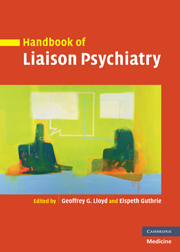Book contents
- Frontmatter
- Contents
- List of contributors
- Preface
- Part I Basic skills
- Part II Common psychiatric problems across the general hospital
- Part III Working with specific units
- 14 Neurological disorders
- 15 Cardiorespiratory disorders
- 16 Gastrointestinal disorders
- 17 Liver disorders
- 18 Endocrine disorders
- 19 Diabetes
- 20 HIV and AIDS
- 21 Renal disease
- 22 Musculo-skeletal disorders
- 23 Oncology
- 24 Head and neck cancer
- 25 Palliative care
- 26 Cosmetic procedures
- 27 Perinatal and gynaecological disorders
- 28 The intensive care unit
- 29 The burns unit
- 30 Psychocutaneous disorders
- 31 Genitourinary disorders
- 32 The emergency department
- Part IV Treatment
- Part V Different treatment settings
- Index
- References
26 - Cosmetic procedures
from Part III - Working with specific units
Published online by Cambridge University Press: 10 December 2009
- Frontmatter
- Contents
- List of contributors
- Preface
- Part I Basic skills
- Part II Common psychiatric problems across the general hospital
- Part III Working with specific units
- 14 Neurological disorders
- 15 Cardiorespiratory disorders
- 16 Gastrointestinal disorders
- 17 Liver disorders
- 18 Endocrine disorders
- 19 Diabetes
- 20 HIV and AIDS
- 21 Renal disease
- 22 Musculo-skeletal disorders
- 23 Oncology
- 24 Head and neck cancer
- 25 Palliative care
- 26 Cosmetic procedures
- 27 Perinatal and gynaecological disorders
- 28 The intensive care unit
- 29 The burns unit
- 30 Psychocutaneous disorders
- 31 Genitourinary disorders
- 32 The emergency department
- Part IV Treatment
- Part V Different treatment settings
- Index
- References
Summary
Introduction
Whatever the reader thinks of aesthetic cosmetic surgery, it is a popular lifestyle choice and attractiveness is a valued attribute in all societies. More than 50% of women and slightly fewer than 50% of men report dissatisfaction with their appearance (Garner 1997). Not surprisingly, many such individuals turn to cosmetic procedures to enhance their appearance. In the USA, 6.6 million procedures were performed in 2002 (American Society for Aesthetic Plastic Surgery 2003). This represents an increase of 1600% over the past decade. Many new procedures have been introduced which are non-surgical and, in the USA, the top six procedures in order of popularity are botox injections, chemical peel, microdermabrasion, laser hair removal, sclerotherapy and collagen injections. The most popular surgical procedures are rhinoplasty, mammaplasty augmentation or lift, liposuction, blepharoplasty, rhytidectomy (face-lift), and mammaplasty reduction. No such figures are available in the UK but, so far as one can tell, the profile is similar to the USA. It is estimated by market analysts that approximately £200 million per annum is spent on cosmetic procedures in the UK in the private sector and that 25% of all bank loans are given for cosmetic surgery.
The availability of cosmetic surgery in the National Health Service (NHS) is patchy. It is viewed by purchasers as a low priority, and there is a clear stigma against psychological distress and handicap caused by minor disfigurement or anomalies.
Keywords
- Type
- Chapter
- Information
- Handbook of Liaison Psychiatry , pp. 617 - 631Publisher: Cambridge University PressPrint publication year: 2007



